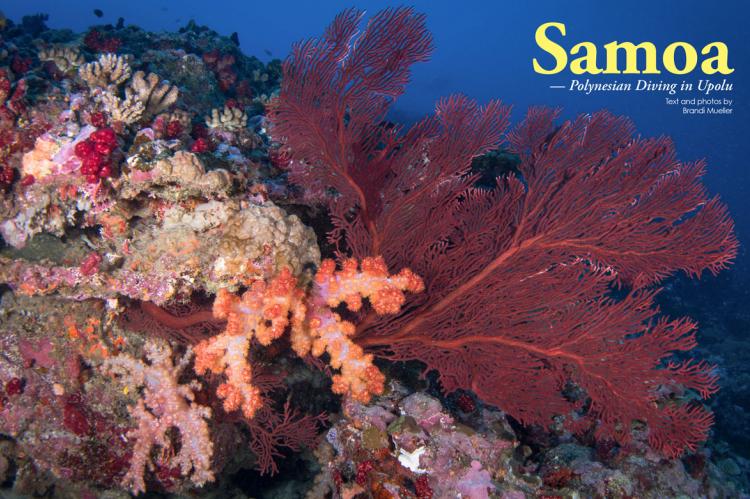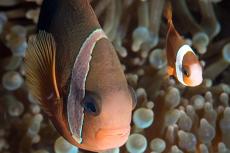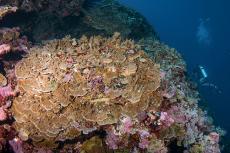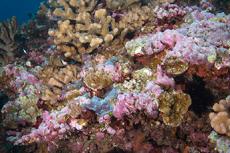Samoa: Polynesian Diving in Upolu
Located in the Polynesian region of the South Pacific Ocean, the idyllic paradise of Samoa, which comprises the two main islands of Savai'i and Upolu and several smaller islands, is part of the Commonwealth of Nations. Brandi Mueller managed to venture to Upolu Island before the coronavirus pandemic forced countries to close borders and stay-at-home orders came into effect. She shares her experience exploring the natural beauty to be found in the Samoan islands, above and below the waves.
Tags & Taxonomy
The small, nine-passenger, turboprop airplane violently shook us up and down like an amusement park ride. Out of the windows, all I could see were the gray clouds of the seemingly endless succession of storms that had been ravaging the area.
Those of us in the back of the small plane could see into the cockpit and past the single pilot’s vision and his view was just as impenetrable with thick, dark clouds as what we saw through our windows. I let out a slightly insensitive giggle on one stomach-dropping descent through the air (I have little fear of airplanes and enjoy a good roller coaster every now and then). But I glanced to my left at a man, white-knuckling his thighs with his eyes closed, and made sure to not make a sound for the rest of the 35-minute flight.
Apia
Our destination was Apia, Samoa, and I was three days late coming in from Pago Pago, American Samoa because the airport had been closed due to a line of tropical storms and cyclones that just did not seem to stop. Several days earlier, my original flight from Honolulu to Pago Pago had also been delayed for 24 hours due to unsafe weather conditions, and when it was time to make this short hop, the storms just kept coming. Once the airport was finally opened, I was on the first flight over, but the weather had not suddenly changed to blue skies and sunshine, and when we landed in Apia, the clouds poured down on us, soaking through layers in my suitcases.
I was feeling quite successful having finally arrived, even with the weather. After clearing immigrations and collecting my luggage, I headed out of the airport, contemplating to myself what a nice airport it was for such a small island, particularly because Talofa Airways (which I was on) lands at the domestic airport. Looking at the arrivals board, I noted a few flights from Australia and New Zealand and a bolt of panic rose up from my stomach. Oh no. We must have landed at the international airport, but I had told the manager at Pure Ocean Dive and Watersports to pick me up at the domestic airport.
Asking around, I discovered the domestic airport was still closed because of the weather, so the flight landed at the international terminal, which was a 45-minute drive from where I had asked to be picked up. A feeling of dread built up inside me that the kind person who volunteered to pick me up might be driving to the wrong place. Not to mention, I was already three days late and had been sending daily emails about cancelled flights and my undetermined arrival. I was feeling terrible for all the inconveniences I was causing.
As I fiddled with my phone, trying to get the international calling plan to work, Oli from Pure Ocean came walking up. He already knew the domestic terminal was closed and the specific terminal in which I would actually be arriving (it is amazing how first impressions and great customer service can calm the panic of a wayward traveler). He also seemed not at all concerned about my being three days late, as we loaded up my luggage and he drove me to the Sheraton Samoa Beach Resort where I would be staying and diving.
After checking into a beautiful ocean-view suite, I enjoyed a lovely outdoor dinner listening to the rain calmly falling and went to bed early. The plan was to dive in the morning, but the weather would dictate if that was going to happen.
Apolima
I opened my eyes to sunshine filling my room and it took me a second to process what the sun was after a week in the South Pacific of solid rain. Looking out the window, it did not even appear windy, so I put my camera together and piled up my dive gear before heading to breakfast.
The resort stretched out along a white sandy beach, with only the occasional palm tree breaking up the 180-degree brilliant blue ocean view and the largest island in Samoa, Savai’i, just a shadow in the background. The tables of the open-air breakfast buffet were arranged, looking out at the sea, and I could not help but marvel at the beautiful view. I wanted to slowly sip my coffee and take it all in, but with hopes the boat might go out, I quickly finished breakfast and headed to the dive shop.
It seemed that perhaps my weather-bad-luck was changing, and the dive crew was loading the boat as I arrived. Pretty soon, we were departing the island of Upolu, heading out to dive Apolima. This extinct volcanic crater is the smallest inhabited island in Samoa, both in size and population, and it is located in between Upolu and Savai’i. Accessible only by boat and only by invitation, you cannot just show up at Apolima.
As the boat made its way closer to the steep black volcanic rock cliffs of the island, I was wondering where the people lived. A small community of about 80 residents was known to live on the island, and as we started to make our way around the island, a small opening appeared. A very narrow, rocky inlet led to a flat interior section of the island with houses. A treacherous landing to say the least, the remnants of a small vessel that met its demise could be seen smashed on the rocks to one side.
Diving
Our destination was not the village though, but instead, dive sites around the island. The boat slowed and my dive guide jumped in to check the current. It was mild and I geared up, back-rolling off the side of the boat. After we met at the surface and descended, all I saw was blue. As I slowly followed the dive guide down, out of nowhere, a massive school of giant barracuda came right up to us. It was like they were waiting to say hello. After I snapped a few photos, they got bored and left, and I could see the seafloor emerging into view at around 30m (100ft).
As we headed to the reef, massive sea fans, which revealed a deep red hue when I shined lights on them, dotted an underwater landscape, swirling with fish. Large hard corals covered the bottom and another large school of a smaller barracuda species overtook us and continued past, out of view. In amongst the hard corals were dots of brightly colored soft corals—not the massive draping kind you see in other places, but numerous smaller patches, like puffballs brightening up the seascape.
While conditions were drastically better than I had expected, the effects of the storms remained in the form of swell. As we got shallower towards the end of the dive, we were tossed back and forth and up and down in the waves. The surf made for a beautiful panorama of white water washing up against the island from below, as we completed our safety stop and headed back to the surface.
The boat was waiting right above us and the captain helped us back onto the boat. Back on board, we continued to circle the island and found another spot to jump in after our surface interval. With another slight current, we drifted along at that perfect speed where you are not going too fast but also do not have to work too much to keep going. It was very relaxing, with lots of marine life to see.
I finished my first day of diving around Apolima, feeling that the diving was just really nice. The water was warm, so a rash guard would have been fine, although I was comfy in a 3mm wetsuit. There were not massive reef structures but endless hard coral plains covering the sea bottom, which supported a lot of fish. Schools of fusiliers passed by. As we came around a corner, the current shifted, but we kicked a bit into it until we got a bit farther and were mobbed by fish. White pyramid butterflyfish, with yellow edges, feasted on plankton in the water column, and a turtle swam by. There were also several anemones with anemonefish within.
Exploring Upolu
Wanting to explore the island, I rented a car and prepared myself to drive around the island. But before they would rent it to me, I had to get a Samoan driver’s license. While it sounded intimidating, it turned out to consist only of filling out a form with the information from my American driver’s license and paying a fee of around US$20, but I felt pride that I passed my Samoan driver’s test.
With 210km (130mi) of beach and roads allowing one to circumnavigate almost the entire island, I set out… on the left side of the road. I found this slightly humorous, having just come from American Samoa where people drove on the right side of the road, and pondered why islands linked so closely culturally (and closely in distance) are so different in practicalities. Doing some research, I found that because Samoa has closer ties with New Zealand and Australia (while American Samoa has closer ties with the United States), far more cars with left-side steering wheels were being imported at cheaper prices into the country. So, in 2009, they decided to just change which side of the road they would drive. On 7 September 2009, they officially changed the law to drive on the left and even made a two-day holiday on the 7th and 8th to help reduce traffic while people started to get used to it.
I admire this move and several others Samoa has done over the years to make the way the country operates make more sense. This includes when, in 2011, the country changed its date and gave up a day by moving itself west of the International Date Line. Previously, Samoa was in the same time zone as American Samoa, but, again, due the country’s close working ties with New Zealand and Australia, they were essentially losing two workdays a week, because when it was Monday in Australia, it was still Sunday in Samoa —so, no one was working. And on Friday in Samoa, it was already Saturday in Australia (and no one was working there). From a business standpoint, it made more sense to change their time zone.
This makes it very interesting to fly from American Samoa to Samoa (which I did), as in a 35-minute flight (125km or 78miles), one goes through a 23-hour time change. Surprisingly, I felt no jet lag.
One last recent change occurred when Western Samoa decided to change its name to Samoa in 1997, dropping the “Western.” This move upset the people of American Samoa as they said it “diminished its own identity.” So, currently, the country is called the Independent State of Samoa, while American Samoa remains an unincorporated and unorganized territory of the United States.
Robert Louis Stevenson Museum
Robert Louis Stevenson (RLS), the Scottish author of the classic books Treasure Island, The Strange Case of Dr Jekyll and Mr Hyde and many other great works, spent the end of his life in Samoa until 1894, when he passed away at age 44. Suffering from illness (possibly tuberculosis) since he was a child, RLS led a life of adventures and travel, and he made his way to the Pacific in 1888, settling in Samoa with his wife, Fanny Van de Grift Osbourne, and her daughter, son and mother in 1890. While in Samoa, they had a mansion built called Vila Vailima, which still stands today and currently serves as a museum, commemorating how he and his family may have lived in Samoa, with original and replica antiques as well as a few first edition books.
Driving just out of Apia and up into the higher elevations of the center of the island, one can see that Vailima was built on a hill, with a beautiful ocean view and in the perfect spot to get trade winds to keep the home cool in the sweltering tropical heat. After removing my shoes (as the Samoans do), a museum guide took me through each room of the house and showed me the kitchen built behind the house (to prevent fires).
The walls were covered in photographs, taken from the 1880s to the 1890s, of the family and staff and of RLS with Samoan villagers. He had close ties with the Samoans, and they called him “Tusitala,” which means “writer of tales.” In RLS’s bedroom and writing room, there were bookshelves full of his books, including translated copies in every language, including Samoan. Several first editions were on display.
My favorite room was Fanny’s, the only room never painted, as she had redwood logs shipped to Samoa for her room, so that she could be surrounded by the trees of her native California. Downstairs in the dining room, there was a massive safe—said to have been carried up the hill on the backs of many Samoans—in which RLS kept his manuscripts locked up, as well as other valuables.
Museum of Samoa
Also in Apia is the Museum of Samoa where I spent some time learning about the culture and history of the islands. On display were pottery and stone artifacts thought to be 3,000 years old, originating from the time when the Samoans first arrived on the islands. Tapa cloths, which are traditional barkcloth made from the paper mulberry tree and painted with intricate designs, were hanging on the walls along with information on Samoa throughout history. As one moved from room to room, the displays chronologically moved through time on the Islands.
Similarities and differences
Prior to arriving in Samoa, I had spent a few days in American Samoa, but unfortunately, I was unable to get into the water due to bad weather and was mostly confined to my Airbnb during Tropical Storm Wasi. But I was fascinated about the similarities and differences between these two very distinct countries, which are so closely tied culturally and physically. The museum shed some light on these differences, yet, the term Talofa (or Hello in English) was still heard on both islands, both cling to the traditions of the Samoan culture, and both live life Fa’a Samoa or “the Samoan Way.”
While driving around Tutulia (American Samoa) and Upulo (Samoa), I observed that every village had at least one (but usually many) fale. Fale means “house” but refers to an oval-shaped building with no walls, just pillars holding it up, and a thatched roof, lashed and tied together with plant fiber rope, usually made from dried coconut fiber. Originally constructed with no metal, now some also use modern construction equipment. They are still used today for meetings and gatherings, and I often saw people just hanging out in them, as I drove through the villages.
On the side of the road, I also often saw large metal tanks (similar to the large cylinders one might use to fill a lot of scuba tanks), hanging with their bottoms cut off, like a bell. I later learned that these were used to alert the village of something important. They also would be sounded to alert people of “Sa” (meaning “sacred”), which is a religious evening prayer curfew, usually around 5:00 to 6:00 p.m. each night. During this time, no one is allowed to walk around the village, from the time the bell was sounded until the bell (or sometimes it was the blowing of a conch shell) was later sounded three times.
Samoans are deeply religious, and Sundays are a day of worship. Almost everything is closed for the day, although hotels and some tourist restaurants stay open. I even saw signs posted at beaches, forbidding swimming on Sundays.
To-Sua Ocean Trench
Continuing my drive around the island, I reached To-Sua Ocean Trench on the southern coast. Meaning “giant swimming hole” in English, To-Sua is a cave, connecting to the open ocean, that can be reached via a descending staircase and ladder. From above, it looks like a giant hole in the ground, which it sort of is, but with plenty of beauty surrounding it. The entrance is located within a native garden, and if you can pull yourself away from the giant swimming hole, you will find that the garden abruptly ends at a cliff with a spectacular view of the Pacific Ocean.
Resuming my driving tour of the island, I stopped at a few waterfalls (there are plenty), and I soon became very familiar with “custom fees,” which are customary fees visitors pay to access sights on private land, such as To-Sua, the waterfalls, and even several beaches. Each time I pulled off the highway towards a “waterfall” sign, I would be met in the parking lot and asked for 10 or 20 tala (about US$7-12). I was glad I brought some cash and small bills with me.
Sopoaga Waterfall was beautiful, and only a few feet from the parking lot. I also stopped at Fuipisia Falls, which required a bit more work to reach. After parking my car and paying the fee, I was sent off along a grassy path, which crossed a small babbling brook and then turned into a very deep and slippery muddy path. I lost my sandals to the thick mud several times before giving up and walking barefoot until I reached the falls when a soft rain started falling, making the mud even worse. The waterfall was gorgeous, though, and green forest surrounded the area.
Traveling during COVID-19
As my trip in Samoa began in mid-February 2020, the island nation was already ramping up its protective measures against COVID-19. The country still has not forgotten the 1919 Spanish Flu outbreak during which it suffered more than any other Pacific Island Nation, as 90 percent of the population got infected and over one-fifth of the population died. In nearby American Samoa, Spanish Flu was prevented entirely due to the governor quarantining the territory and not allowing any ships in. Samoa had no cases until the arrival of the SS Talune from New Zealand, and seven days later, the epidemic was uncontrollable.
While I was reading about this event in the Museum of Samoa, I was also getting updates of COVID-19 cases occurring around the world. On arrival to Samoa, I was temperature-checked and passengers who had been to China, Italy, Iran, or coming from California in the United States were not allowed to enter. I had not left the Pacific in over two months and had not been in or traveled through any countries that had confirmed cases prior to my arrival in Samoa. But stricter measures were being taken every day, including halting cruise ships from docking.
The day I left Samoa, the Samoan government cut flights in half and increased the number of countries not allowed entry to try and stop Samoa from becoming infected with the virus. Although I am sure this did harm to tourism, in a country with a vulnerable population and a healthcare system that most likely could not support a pandemic, these were likely very good (and very quick) responses to protect Samoans from the virus.
Macro critters
On my last morning of diving in Samoa, I made the tough decision to put on my macro lens and capture some of the lovely reef fish I had been seeing on every dive. Samoa was a hard place to choose to shoot macro because every dive had the possibility of seeing larger animals like turtles, reef and nurse sharks, as well as endless fields of coral. But during my dives, I was glad I did, as I chased around butterflyfish and tried to capture the many black and white dascyllus, which would hover above the hard coral only to dart back into the branches and hide whenever I was about to snap a photo.
Throughout my dives in Samoa, I had occasionally seen a large blenny, with bright reddish orange spots, sitting on rocks or on coral. I made it my goal to get a photo of this one and probably bored my dive guide to tears as I stayed in one section trying to follow the skittish blenny. I did snap an image of one that sat still long enough. There were also numerous different-colored giant clams all over the reef, ranging from purple to orange to deep blue.
With my nose in the coral, my dive guide called me over and showed me the tiniest blenny, smaller than a pencil eraser hiding in a small hole showing only his head. I am still not certain what species it was, but it sure was cute!
Snorkeling
Back on the boat, I was content with my macro morning and was debating in my head if I should spend the afternoon relaxing at the pool or the beach when Oli called from the office. He asked if I wanted to join a snorkeling trip going out in the afternoon, which would visit Nu’ulopa Island (also known as Bat Island, home to a conservation area for flying foxes). That seemed like the perfect place to fly my drone, so I quickly abandoned my visions of napping in a beach chair.
With plenty of shallow reef teeming with fish, Samoa has some great snorkeling. But I was excited for the snorkeling surface interval on the small island known for its bat population (Fun fact: Bats do not like drones). The small island was covered in palms and other trees, and I learned it was sometimes used as a cemetery for high chiefs.
Samoan music and dance
After the island visit and more snorkeling, I got back to my room to change quickly and make my way to the "Fia Fia." Roughly translating to “celebration” or “happy,” the Sheraton Samoa Beach Resort does a weekly traditional dinner show with Samoan dancing and music.
While we guests sipped cocktails and enjoyed traditional Samoan cuisine, several stories of Samoa were relayed to us via music and dance. The highlight of the evening was the fire dancers at the end of the show.
Since I was flying out the next day, when the forecast also called for rain, this seemed like a perfect way to end my trip to Samoa. The sun was setting over the tranquil blue ocean, and I was already making a mental list of things to come back to do and see: Do more hiking, visit Savai’i, and, of course, do more diving. ■
Special thanks go to Pure Ocean Dive and Watersports and the Sheraton Samoa Beach Resort.
American underwater photographer, dive writer and regular contributor Brandi Mueller is a PADI IDC Staff Instructor and boat captain living in Micronesia. When she is not teaching scuba or driving boats, she is most happy traveling and being underwater with a camera. Mueller’s book, Airplane Graveyard, featuring her underwater photos of forgotten American WWII airplanes at the bottom of the Kwajalein Atoll lagoon, is available at: Amazon.com. For more information, please visit: Brandiunderwater.com.
Download the full article ⬇︎





























































